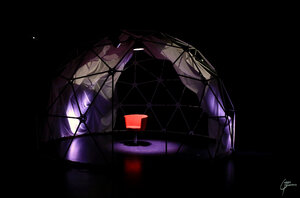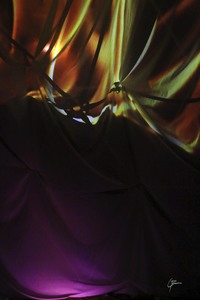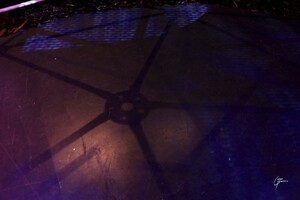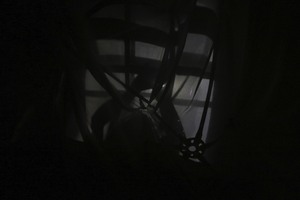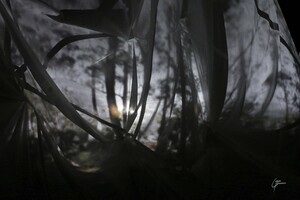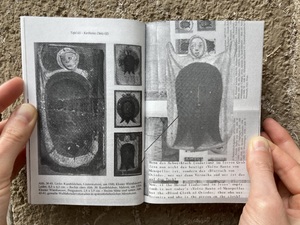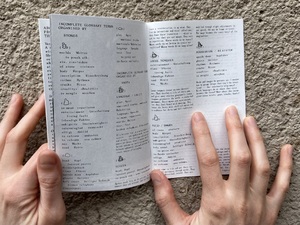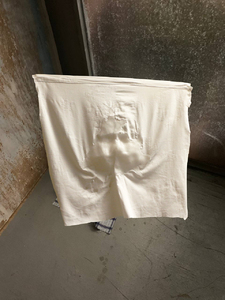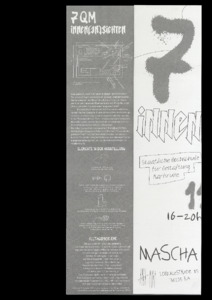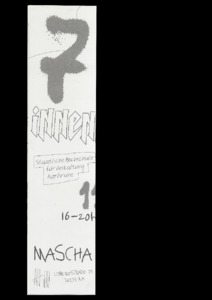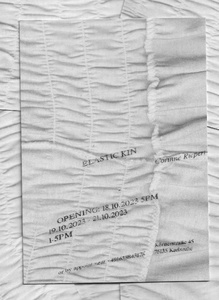"Szenografie"
| Begriff | Szenografie |
| Metakey | Studiengang (institution:program_of_study) |
| Typ | Keyword |
| Vokabular | HfG |
393 Inhalte
- Seite 1 von 33
Duschgel als Raumduft
- Titel
- Duschgel als Raumduft
- Titel (en)
- 7sqm Inside Views
- Autor/in
- Beschreibung (de)
- Die unterschiedlichen filmische Sequenzen waren als Projektionen im Raum (großes Studio) auf Wänden zu sehen. Sie erzählen von Überlebensstrategien auf engem Raum, von der Subkultur im Gefängnis:
Sucuk aus dem Wasserkocher, Gebetsketten aus Brot,
Apfelbäume aus Joghurtbechern und Duschgel als Raumduft.
Die Sequenzen sind Erzählungen aus dem Interview mit Badaue (Pseudonym). Die zu sehenden Handlungen hat er, während der Zeit der Untersuchungshaft, zum Teil selbst entwickelt, zum Teil von anderen Inhaftierten erfahren.
- Die unterschiedlichen filmische Sequenzen waren als Projektionen im Raum (großes Studio) auf Wänden zu sehen. Sie erzählen von Überlebensstrategien auf engem Raum, von der Subkultur im Gefängnis:
- Beschreibung (en)
- The different film sequences were shown as projections in the room (Studio) on walls. They tell of survival strategies in confined spaces, of the subculture in prison:
Sucuk from a kettle, prayer chains made of bread,
apple trees from yogurt pots, and shower gel as a room scent.
The sequences are narrations from the interview with Badaue (pseudonym). He developed the actions to be seen, during the time of pre-trial detention, partly himself, partly experienced from other detainees.
- The different film sequences were shown as projections in the room (Studio) on walls. They tell of survival strategies in confined spaces, of the subculture in prison:
- Typ des Projekts/Werks
- Schlagworte
- Mitwirkende
- Material
- Technik/Verfahren/Formate
- MP4
- Abmessungen
- 1620 × 1080
- Ort: Institution
- Ort
- großes Studio
- Stadt
- Land
- Titel
- Duschgel als Raumduft
- Urheberrechtshinweis
- Mascha Dilger, Tibor Pilz, Alexander Thelen, Badaue
- Rechtsschutz/Lizenz
- Freigabe Nutzung HfG
- Medienersteller/in
- Projektleiter/in
- Semester
- Studiengang
- Typ der Abschlussarbeit
- Importiert am
- 31.07.2023
- Übergeordnete Sets
- 1
ERLEBNIS THEATER: Ausstellungsansicht
- Titel
- ERLEBNIS THEATER: Ausstellungsansicht
- Autor/in
- Kategorie
- Schlagworte
- Datierung
- Mai 2021
- Ort: Institution
- Ort
- Großes Studio
- Stadt
- Land
- Titel
- ERLEBNIS THEATER: Ausstellungsansicht
- Titel (en)
- ERLEBNIS THEATER: exhibition view
- Urheberrechtshinweis
- © Carina Fenderich
- Rechtsschutz/Lizenz
- Freigabe Nutzung HfG
- Medienersteller/in
- Beziehung/Funktion
- Projektleiter/in
- Semester
- Studiengang
- Typ der Abschlussarbeit
- Importiert am
- 14.06.2024
- Übergeordnete Sets
- 1
ERLEBNIS THEATER: Ausstellungsansicht
- Titel
- ERLEBNIS THEATER: Ausstellungsansicht
- Autor/in
- Kategorie
- Schlagworte
- Datierung
- Mai 2021
- Ort: Institution
- Ort
- Großes Studio
- Stadt
- Land
- Titel
- ERLEBNIS THEATER: Ausstellungsansicht
- Titel (en)
- ERLEBNIS THEATER: exhibition view
- Urheberrechtshinweis
- © Carina Fenderich
- Rechtsschutz/Lizenz
- Freigabe Nutzung HfG
- Medienersteller/in
- Beziehung/Funktion
- Projektleiter/in
- Semester
- Studiengang
- Typ der Abschlussarbeit
- Importiert am
- 14.06.2024
- Übergeordnete Sets
- 1
ERLEBNIS THEATER: Ausstellungsansicht
- Titel
- ERLEBNIS THEATER: Ausstellungsansicht
- Autor/in
- Kategorie
- Schlagworte
- Datierung
- Mai 2021
- Ort: Institution
- Ort
- Großes Studio
- Stadt
- Land
- Titel
- ERLEBNIS THEATER: Ausstellungsansicht
- Titel (en)
- ERLEBNIS THEATER: exhibition view
- Urheberrechtshinweis
- © Carina Fenderich
- Rechtsschutz/Lizenz
- Freigabe Nutzung HfG
- Medienersteller/in
- Beziehung/Funktion
- Projektleiter/in
- Semester
- Studiengang
- Typ der Abschlussarbeit
- Importiert am
- 14.06.2024
- Übergeordnete Sets
- 1
ERLEBNIS THEATER: Ausstellungsansicht
- Titel
- ERLEBNIS THEATER: Ausstellungsansicht
- Autor/in
- Kategorie
- Schlagworte
- Datierung
- Mai 2021
- Ort: Institution
- Ort
- Großes Studio
- Stadt
- Land
- Titel
- ERLEBNIS THEATER: Ausstellungsansicht
- Titel (en)
- ERLEBNIS THEATER: exhibition view
- Urheberrechtshinweis
- © Carina Fenderich
- Rechtsschutz/Lizenz
- Freigabe Nutzung HfG
- Medienersteller/in
- Beziehung/Funktion
- Projektleiter/in
- Semester
- Studiengang
- Typ der Abschlussarbeit
- Importiert am
- 14.06.2024
- Übergeordnete Sets
- 1
ERLEBNIS THEATER: Ausstellungsansicht
- Titel
- ERLEBNIS THEATER: Ausstellungsansicht
- Autor/in
- Kategorie
- Schlagworte
- Datierung
- Mai 2021
- Ort: Institution
- Ort
- Großes Studio
- Stadt
- Land
- Titel
- ERLEBNIS THEATER: Ausstellungsansicht
- Titel (en)
- ERLEBNIS THEATER: exhibition view
- Urheberrechtshinweis
- © Carina Fenderich
- Rechtsschutz/Lizenz
- Freigabe Nutzung HfG
- Medienersteller/in
- Beziehung/Funktion
- Projektleiter/in
- Semester
- Studiengang
- Typ der Abschlussarbeit
- Importiert am
- 14.06.2024
- Übergeordnete Sets
- 1
everyone (dt.: alle)
- Titel
- everyone (dt.: alle)
- Schlagworte
- Titel
- everyone (dt.: alle)
- Titel (en)
- everyone
- Urheberrechtshinweis
- © Hanna Franke
- Rechtsschutz/Lizenz
- Freigabe Nutzung HfG
- Medienersteller/in
- Beziehung/Funktion
- Medien-Beschreibung
- Doppelseite des Readers zu „I used to think that I was made of Stone“.
(„everyone“, 9,5 x 15,2 cm, 36 Seiten)
- Doppelseite des Readers zu „I used to think that I was made of Stone“.
- Medien-Beschreibung (en)
- Double-page spread of the accompanying reader for “I used to think that I was made of Stone”.
(“everyone”, 9,5 x 15,2 cm, 36 pages)
- Double-page spread of the accompanying reader for “I used to think that I was made of Stone”.
- Alternativ-Text (de)
- Zwei Hände halten ein Heft vor eine Wand. Es zeigt mehrere Abbildungen in schwarz-weiß. Variationen einer Figur mit einem großen hellen Gewand, auf dem ein Gesicht abgebildet ist. Auf der rechten Seite steht unter dem vergößerten Bild der Text: "Wenn das Schweißtuch (sudarium) im leeren Grab Jesu nun nicht das heutige 'Volto Santo von Manopello' ist, sondern das 'Bluttuch von Oviedo', wer war dann Veronika und wer ist das auf dem Tuch?" auf Englisch und Deutsch.
- Alternativ-Text (en)
- Two hands holding a booklet in front of a wall. It shows several illustrations in black and white. Variations of a figure with a large light-colored robe on which a face is depicted. On the right-hand side under the enlarged image stands the text: “Now, If the Shroud (sudarium) in Jesus‘ empty tomb is not today's ’Volto Santo of Manopello‘, but the ’Blood Cloth of Oviedo', then who was Veronica and who is the person on the cloth?” in German and English.
- Projektleiter/in
- Semester
- Studiengang
- Typ der Abschlussarbeit
- Importiert am
- 15.11.2024
- Übergeordnete Sets
- 1
everyone (dt.: alle)
- Titel
- everyone (dt.: alle)
- Schlagworte
- Titel
- everyone (dt.: alle)
- Titel (en)
- everyone
- Urheberrechtshinweis
- © Hanna Franke
- Rechtsschutz/Lizenz
- Freigabe Nutzung HfG
- Medienersteller/in
- Beziehung/Funktion
- Medien-Beschreibung
- Doppelseite des Readers zu „I used to think that I was made of Stone“.
(„everyone“, 9,5 x 15,2 cm, 36 Seiten)
- Doppelseite des Readers zu „I used to think that I was made of Stone“.
- Medien-Beschreibung (en)
- Double-page spread of the accompanying reader for “I used to think that I was made of Stone”.
(“everyone”, 9,5 x 15,2 cm, 36 pages)
- Double-page spread of the accompanying reader for “I used to think that I was made of Stone”.
- Alternativ-Text (de)
- Übersicht verschiedener Worte, kurzer Texte und Symbole. Die deutsche Übersetzung der Überschrift lautet: „Unvollständige Glossarbegriffe, sortiert nach Steinen“.
- Alternativ-Text (en)
- Overview of words, several short texts and signs. The heading says: “Incomplete Glossary Terms organised by stones”.
- Projektleiter/in
- Semester
- Studiengang
- Typ der Abschlussarbeit
- Importiert am
- 15.11.2024
- Übergeordnete Sets
- 1
face imprint (dt.: gesichtsabdruck)
- Titel
- face imprint (dt.: gesichtsabdruck)
- Schlagworte
- Titel
- face imprint (dt.: gesichtsabdruck)
- Titel (en)
- face imprint
- Urheberrechtshinweis
- © Hanna Franke
- Rechtsschutz/Lizenz
- Freigabe Nutzung HfG
- Beziehung/Funktion
- Alternativ-Text (de)
- Freigestelltes Objekt: ein heller Stoff mit einem Gesichtsabdruck aus Wachs. Im Hintergrund ist ein Teil einer Fensterscheibe und eine Holzfensterbank zu sehen.
- Alternativ-Text (en)
- Isolated object: a light-colored fabric with a wax face imprint. Part of a window pane and a wooden window sill can be seen in the background.
- Projektleiter/in
- Semester
- Studiengang
- Typ der Abschlussarbeit
- Importiert am
- 02.11.2024
- Übergeordnete Sets
- 1
Flyer
- Titel
- Flyer
- Titel (en)
- 7sqm - inside views
- Autor/in
- Beschreibung (de)
- Der Flyer (der gleichzeitig auch als Poster funktioniert) wurde, begleitend zur Ausstellung, und zum mitnehmen ausgelegt.
- Der Flyer (der gleichzeitig auch als Poster funktioniert) wurde, begleitend zur Ausstellung, und zum mitnehmen ausgelegt.
- Beschreibung (en)
- The flyer (which also works as a poster) was put out for the exhibition and to take home.
- Typ des Projekts/Werks
- Schlagworte
- Datierung
- 11.07.2023 - 12.07.2023
- Mitwirkende
- Dank an
- Sprache
- Material
- Technik/Verfahren/Formate
- A2, gefaltet
- Abmessungen
- 42 x 59,4 (BH) (Poster), 13,3 x 59,4 (BH) (Flyer)
- Ort: Institution
- Ort
- im großen Studio
- Stadt
- Land
- Titel
- Flyer
- Urheberrechtshinweis
- Mascha Dilger, Laurine Haller, Pauline Mimberg
- Rechtsschutz/Lizenz
- Freigabe Nutzung HfG
- Semester
- Studiengang
- Typ der Abschlussarbeit
- Importiert am
- 26.07.2023
- Übergeordnete Sets
- 1
Flyer
- Titel
- Flyer
- Titel (en)
- 7sqm - inside views
- Autor/in
- Beschreibung (de)
- Der Flyer (der gleichzeitig auch als Poster funktioniert) wurde, begleitend zur Ausstellung, und zum mitnehmen ausgelegt.
- Der Flyer (der gleichzeitig auch als Poster funktioniert) wurde, begleitend zur Ausstellung, und zum mitnehmen ausgelegt.
- Beschreibung (en)
- The flyer (which also works as a poster) was put out for the exhibition and to take home.
- Typ des Projekts/Werks
- Schlagworte
- Datierung
- 11.07.2023 - 12.07.2023
- Mitwirkende
- Dank an
- Sprache
- Material
- Technik/Verfahren/Formate
- A2, gefaltet
- Abmessungen
- 42 x 59,4 (BH) (Poster), 13,3 x 59,4 (BH) (Flyer)
- Ort: Institution
- Ort
- im großen Studio
- Stadt
- Land
- Titel
- Flyer
- Urheberrechtshinweis
- Mascha Dilger, Laurine Haller, Pauline Mimberg
- Rechtsschutz/Lizenz
- Freigabe Nutzung HfG
- Semester
- Studiengang
- Typ der Abschlussarbeit
- Importiert am
- 26.07.2023
- Übergeordnete Sets
- 1
Flyer/ Einladung
- Titel
- Flyer/ Einladung
- Untertitel
- Elastic Kin
- Autor/in
- Beschreibung (de)
- Die Rauminstallation “Elastic Kin” zeigt eine Gruppe von Textilobjekten - Gefüge -, die aus weggeworfenen Kleidungsstücken bestehen. Sie existieren sowohl als Individuen als auch als Gruppe. Die Kleidungsstücke, die in den Straße von K. gefunden wurden und von Anderen in anderen Kontext hergestellt worden sind, kehren ihren ursprünglichen Zweck um, indem sie zu eigenen Körpern werden, die unabhängig von menschlichen Körpern sind. Jede Oberfläche ist wie eine geheime Landkarte, die Spuren anonymer Hände enthält, die an den Textilien gearbeitet haben.
Der Sound der Installation ist ein Echo - fast verschwundener, kollektiver Erinnerungen an vergangene Momente und Orte.
“Elastic Kin” versucht, eine weit verbreitete Verwandtschaft darzustellen, die durch unsichtbare, lose und elastische Fäden imaginiert wird, die ein internationales System von Lieferketten, Arbeiter*Innen und Konsument*Innen, Trendprognosen und unvorhersehbarem Zeitgeist, Massenproduktion und meditativer Handarbeit abbilden. Welche Spuren dieser Kontexte enthalten die Kleidungsstücke?
Das Video zeigt eine performative Intervention im öffentlichen Raum. Es zeigt die Gefüge, die eine neue Existenz außerhalb ihrer Produktions- und Vermarktungskontexte führen: Sie kehren in ein Einkaufszentrum zurück, animiert von den Menschen, die sie einst bekleideten.
- Die Rauminstallation “Elastic Kin” zeigt eine Gruppe von Textilobjekten - Gefüge -, die aus weggeworfenen Kleidungsstücken bestehen. Sie existieren sowohl als Individuen als auch als Gruppe. Die Kleidungsstücke, die in den Straße von K. gefunden wurden und von Anderen in anderen Kontext hergestellt worden sind, kehren ihren ursprünglichen Zweck um, indem sie zu eigenen Körpern werden, die unabhängig von menschlichen Körpern sind. Jede Oberfläche ist wie eine geheime Landkarte, die Spuren anonymer Hände enthält, die an den Textilien gearbeitet haben.
- Beschreibung (en)
- The spatial installation “Elastic Kin” shows a group of textile objects – Gefüge – that were assembled from discarded and abandoned garments. They exist as individuals as well as a kin. Assembled from used garments, found in the streets of K., produced by others in other contexts, they invert their original purpose by becoming bodies of their own, no longer dependent on being activated by a human body. The surface of every Gefüge is like a secret map, containing traces of anonymous hands working on them.
The sound in the installation is an echo of almost vanished collective memories of past moments and places. “Elastic Kin” attempts to depict a widespread kinship, that is imagined through invisible, loose and elastic threads mapping an international system of supply chains, workers and consumers, trend forecast and unpredictable zeitgeist, mass production and meditative handcraft. Which traces of these contexts do the garments contain?
The video shows a performative intervention in pub- lic space. It shows the Gefüge leading a new existence outside their production and marketing contexts: They return to the shopping mall, animated by the people, they once used to dress.
- The spatial installation “Elastic Kin” shows a group of textile objects – Gefüge – that were assembled from discarded and abandoned garments. They exist as individuals as well as a kin. Assembled from used garments, found in the streets of K., produced by others in other contexts, they invert their original purpose by becoming bodies of their own, no longer dependent on being activated by a human body. The surface of every Gefüge is like a secret map, containing traces of anonymous hands working on them.
- Typ des Projekts/Werks
- Schlagworte
- Datierung
- 18.10.2023
- Mitwirkende
- Dank an
- Sprache
- Untertitel (Film)
- Material
- Ort: Institution
- Stadt
- Land
- Titel
- Flyer/ Einladung
- Urheberrechtshinweis
- Corinne Riepert / Dshamilja Tükerek
- Rechtsschutz/Lizenz
- Freigabe Nutzung HfG
- Medienersteller/in
- Beziehung/Funktion
- Projektleiter/in
- Semester
- Studiengang
- Typ der Abschlussarbeit
- Importiert am
- 02.11.2023
- Übergeordnete Sets
- 1
